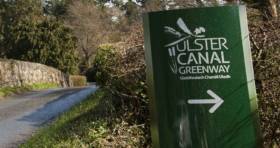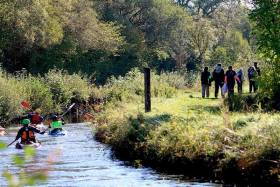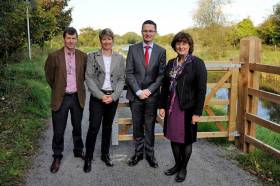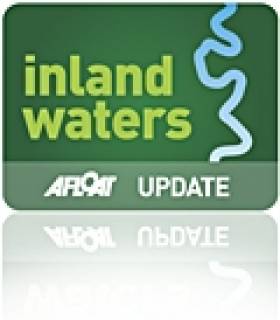Displaying items by tag: Greenway
The Historic 130km Royal Canal Greenway Officially Launches
The Royal Canal Greenway, a scenic 130km walking and cycling amenity stretching alongside the historic 225-year-old canal, officially launches today ahead of the summer 2021 season. The €12 million project co-ordinated by Waterways Ireland is the country’s longest Greenway, traversing through Kildare, Meath, Westmeath and Longford. Those wishing to experience the Royal Canal Greenway are advised to adhere to Government guidelines on movement and social distancing.
The newest outdoor adventure tourism attraction for the country, the Royal Canal Greenway is a former towpath for barges featuring 90 bridges, 33 locks, 17 harbours and four aqueducts. Greenway users can choose to complete the entire 130km flat, off-road trail in one visit or explore the shorter designated routes — ranging from 6km to 15km — between the 14 connecting access points and towns.
 Longford Bridge, Ballymahon in County Longford on the Royal Canal Greenway
Longford Bridge, Ballymahon in County Longford on the Royal Canal Greenway
High-profile attractions linking onto the Royal Canal Greenway are trails to Carton House in Maynooth; Corlea Trackway Visitor Centre — one of the largest prehistoric roads in Europe — in Longford; and Center Parcs. The 165km self-guided National Famine Way also travels largely along the Greenway, following the footsteps of 1,490 emigrants who walked from Roscommon to Dublin at the peak of the famine in 1847.
Speaking on the official Greenway opening, Minister for Transport, Eamon Ryan TD said: “We are delighted to launch the Royal Canal Greenway, a game changer for outdoor tourism, and leisure in Ireland and part of a growing network of greenways we will fund over the lifetime of this government. As Ireland’s longest greenway, stretching from the towns of Maynooth, Enfield, Mullingar, Longford and Cloondara, the Royal Canal Greenway has huge potential to serve as a haven for so many looking to get out and get active.
“In the past year, Ireland’s great outdoors has proved to be a lifeline for the nation, with a surge in those running, walking and cycling. When we travel again, the Royal Canal Greenway will be a fantastic attraction ready to be enjoyed by all and is easily accessible from towns and cities across Ireland including via public transport. There really is no better way to experience the unspoilt open scenery, wonderful waterways, peaceful atmosphere and rich history of Ireland’s Ancient East and Hidden Heartlands than on the off-road Royal Canal Greenway.”
 The Royal Canal Greenway at Westmeath
The Royal Canal Greenway at Westmeath
The Greenway has been completed in partnership with Waterways Ireland; the four local authorities of Kildare, Longford, Meath and Westmeath County Councils; the Department of Transport, and Transport Infrastructure Ireland.
Minister of State at the Department of Housing, Local Government and Heritage, Malcolm Noonan, TD added: “This is a Greenway that has a remarkable past. From its tragic connection with the famine, to its heyday in the mid-1880s when it was the motorway of its time, the Royal Canal Greenway is an amenity that is continually reimagining and reinventing itself. It is fantastic to see it become a significant outdoor tourism and leisure amenity for Ireland — a 225-year-old engineering marvel that is now a respite for the modern age. As we look to a greener future, this Greenway will be an instrumental vehicle for the promotion and development of sustainable tourism in Ireland.”
CEO of Waterways Ireland John McDonagh stated: “We thank all stakeholders for their involvement, in particular the local communities who have been so invested in this Greenway. For them, this will have added economic benefits through job and new business creation with a wide range of accommodation options, bike hire offerings, attractions, as well as restaurants and cafes along the route. We ask the people of Ireland, when safe to do so, to uncover the treasures of the Royal Canal Greenway, an unforgettable new addition to the Irish outdoor adventure scene.”
 Kilcock Harbour in Kildare on the Royal Canal Greenway
Kilcock Harbour in Kildare on the Royal Canal Greenway
The Royal Canal Greenway also forms part of EuroVelo 2, a 5,000km “Capitals Route” that passes through Ireland, the UK, the Netherlands, Germany, Poland, Belarus and Russia.
#InlandWaters - A series of three ‘community information events’ on the next phase of the Ulster Canal Greenway begins this week, with a meeting at Tyholland Community Centre in Co Monaghan from 4pm to 8pm tomorrow (Tuesday 2 October).
This will be followed by events at Middletown Community Parish Hall, Co Armagh on Wednesday 10 October, and Smithborough Community Hall, Co Monaghan on Thursday 18 October, both also from 4pm to 8pm.
Waterways Ireland; Monaghan County Council; Armagh City, Banbridge and Craigavon Borough Council; and East Border Region Ltd are working in partnership to deliver Phase 2 of the Ulster Canal Greenway.
Landowners, local communities and the general public are invited to these information events to find out more about the project.
#InlandWaters - Tourism and activity providers along with local communities along the route are invited to attend a series of workshops aimed at developing the Royal Canal as an attraction for domestic tourism and visitors from abroad.
Coming ahead of next year’s launch of the Royal Canal Greenway, the capacity-building workshops will help project partners engage with local trades, businesses and others to showcase the proposed plans in developing the Royal Canal as a destination.
The long-awaited Blueway and Greenway trails on and along the 144km of canal and towpath from Dublin to Longford will be the focus of the workshops, the first of which will be held next week in Mullingar on Thursday 24 May from 6.30pm at the Mullingar Park Hotel.
Dates and venues for subsequent workshops in Longford town, Maynooth and Dublin are to be confirmed. All are hosted by Waterways Ireland with the respective local authorities.
Once complete, the Royal Canal Greenway will be the longest off-road walking and cycling trail on the island of Ireland.
Accompanying this will be a series of Blueway developments, the first being located in Mullingar where a 22km paddling trail and activity hub will be established.
The workshops will encourage the development of activity based packages, dining and accommodation packages and promotional materials which will activate the region and place the product in the ‘shop window’ for both the domestic and international tourist.
The Royal Canal is also at the heart of Ireland’s Ancient East and Ireland’s Hidden Heartlands, two tourism initiatives developed by Fáilte Ireland.
EU-Funded €4.95m Ulster Canal Greenway Project is Launched
The Minister for Transport, Tourism and Sport, Shane Ross TD and the Minister for Culture, Heritage and the Gaeltacht, Heather Humphreys TD, have today launched the EU-funded €4.95m Ulster Canal Greenway Project which will see the development of an off-road sustainable travel route between Smithborough, Co Monaghan and Middletown, Co Armagh.
The project is supported by the European Union's INTERREG VA Programme, managed by the Special EU Programmes Body (SEUPB). The project is also supported by the Department of Transport, Tourism and Sport in Ireland and the Department for Infrastructure in Northern Ireland. The project partners, led by Waterways Ireland, are Monaghan County Council, Armagh City, Banbridge & Craigavon Borough Council and East Border Region Ltd.
Minister Ross stated “This is a wonderful initiative. Greenways connect communities, promote healthier lifestyles and encourage engagement with the outdoors. They also offer active travel opportunities for both pedestrians and cyclists and have proven to be a major attraction for visitors.
I’m very pleased to be launching Phase 2 of the Ulster Canal Greenway here today. Creating a new Greenway involves years of planning, construction and goodwill from those in surrounding lands. But it’s a commitment that delivers back to the community in spades. This Greenway promises to be a major asset to surrounding areas, as it brings the old towpaths of the disused Ulster Canal back into use and extends the Monaghan Town Greenway by 22km in a very welcome cross-border project. By 2020, the Greenway will link Smithborough, Co Monaghan to Middleton, Co Armagh.
I very much look forward to making use of it in the future and I encourage you all to do likewise.”
The Ulster Canal Greenway (UCG) Phase 2 project is a pioneering move to develop the first sustainable transport alternative for cross-border commuters between Smithborough, Co. Monaghan and Middletown, Co. Armagh. Monaghan to Northern Ireland is the second highest of all South-North commuter flows, and Armagh to Ireland is the third highest of all North-South flows. The project valued at €4.95m aims to construct 22km of new cross-border Greenway by 2020 and actively to promote commuter behavioural change through a targeted community engagement programme. It will result in a 4.5% increase in the number of cross-border journeys via walking / cycling by 2023. The project is designed to connect with the completed Phase I section, which utilises the disused Ulster Canal to provide a highly strategic route linking the east/ west sides of Monaghan.
Minister Heather Humphreys in whose constituency the Greenway will run, said at the launch
“I am delighted that Waterways Ireland, an agency under the remit of my own Department, have agreed to act as the lead partner for this flagship cross-border project. The first phase of the Greenway, here in Monaghan, already attracts over 100,000 users per year and has been a fantastic success since it opened in 2014. The further expansion of the Greenway will strengthen cross border relations by directly linking communities North and South of the border. The provision of this landmark recreational amenity will also provide a huge tourism boost for County Monaghan and the wider border region. “
Speaking at the event Gina McIntyre, Chief Executive Officer with the Special EU Programmes Body, said: “When completed this cross border project will help to meet some important targets under the sustainable transport objective of the EU’s INTERREG VA Programme. It will encourage more people to get out of their cars and increase the number of cross-border journeys made by walking and cycling, thereby helping to reduce our collective carbon footprint.
“Not only will this produce many benefits for the region, but the project is also making a contribution towards the EU’s ‘Europe 2020’ strategy which has been specifically designed to reduce greenhouse gas emissions and help safeguard the environment,” she continued.
Also attending the launch on the day were children from St John’s Primary School, Middletown, Co Armagh and Gaelscoil Ultain, St Marys Boys School and St Louis Girls School The extended Ulster Canal Greenway route will create the first cross-border greenway that will enable cyclists and walkers commute to work and study in future years.
The Cathaoirleach of Monaghan County Council Cllr Cathy Bennett stated ‘The 4km Monaghan Town Greenway has been a huge success and it attracts over 100,000 users annually. I am delighted that the INTERREG VA programme is supporting the next 22km section of the Ulster Canal Greenway. This new phase of the greenway will join communities north and south of the border, bringing huge benefits to our area and encouraging even more people to get out walking and cycling on a daily basis.’
Alderman Elizabeth Ingram, Armagh City, Banbridge & Craigavon Borough Council stated "A key facet of our vision is to engage and support initiatives that protect and safeguard our environment for future generations to come that is why we are delighted to partner up on the EU funded Ulster Canal Greenway project. Bringing about substantial environmental benefits whilst enhancing the quality of life in the area, this pioneering project will deliver an alternative and sustainable pathway for cyclists and walkers to commute between both sides of the border. The collaborative project highlights our commitment to growing a connected, welcoming and healthy community.”
The project will also contribute to a deepened level of partnership between key stakeholders and to the development of expertise and dissemination of best practice in delivering cross-border projects.
Longest Greenway in Ireland to officially open Saturday
Waterford Greenway, the longest off-road walking and cycling experience in Ireland, is to officially open tomorrow, Saturday (March 25). The eagerly awaited €15 million project stretches 46km from Waterford City to Dungarvan along the former Great Southern and Western Railway line.
The major tourism initiative now features in the Atlantic Coast Route of EuroVelo, a long distance cycling network connecting Europe. It is also part of Fáilte Ireland’s Ancient East experience.
The official opening of the Greenway will take place at the old Kilmacthomas Station House, the half-way mark on the dedicated walking and cycling path. Minister for Housing, Planning and Local Government, Simon Coveney TD will attend the ribbon cutting ceremony. Multiple family-friendly events will also take place on Saturday at Waterford Institute of Technology’s West Campus, the Dungarvan Causeway and Kilmacthomas village.
Speaking ahead of the launch, Mayor of Waterford, Cllr Adam Wyse outlined: “It is fitting that the Waterford Greenway officially opens on March 25th, exactly 50 years after the last passenger train travelled along the old railway line between Dungarvan and Waterford. The Waterford Greenway is steeped in history and natural heritage, and I’m delighted to see it now re-imagined into an amenity that will continue to give great enjoyment to the people of Waterford and visitors to this great county well into the future.”
The Waterford Greenway was developed by Waterford City and County Council with the co-operation of local property owners and communities along the route, and supporting funding from the Department of Transport, Tourism and Sport.
Also attending the official opening will be Chief Executive of Sport Ireland, Olympic silver medallist and Waterford native, John Treacy, who said: “Participation in sport and physical activity across all ages and backgrounds is vitally important. Having a world-class facility like the Greenway, with its beautiful vista and fantastic amenities, will encourage and provide opportunities to people of all ages, the length and breadth of Waterford, to get out and get active.
“I am also delighted that Waterford Greenway will be the 900th trail listed on the National Trails Register, which is managed by Sport Ireland.”
The route features 11 bridges, three viaducts and a 400-metre tunnel and takes in Waterford City, Mount Congreve, Kilmeaden, Kilmacthomas, Shanacool, Scartore and Dungarvan.
Saturday’s celebrations between 12pm and 4pm include a Viking Village and live music at WIT West Campus, while at Kilmacthomas village, revellers are invited to step back in time with a vintage car display and traditional Fair Day Mart. At the Dungarvan Causeway, there will be fairground rides, live music, juggling and stilt walking. There will also be free walks and talks throughout the afternoon, along with railway heritage exhibitions at Waterford County Museum in Dungarvan, and Kilmacthomas Library.
New Royal Canal Greenway Section Opened In Westmeath
#InlandWaters - The extension of the Royal Canal Greenway in Westmeath from Coolnahay Harbour to the Longford county boundary was officially opened last week.
The new greenway, a 14.4km cycle way, links with the 32.6km already provided along the waterway under an earlier scheme.
Minister of State for Tourism and Sport Patrick O'Donovan joined Cllr Frank McDermott, Cathaoirleach of Westmeath County Council and Waterways Ireland chief executive Dawn Livingstone to officially opened this phase of the cycle way on Friday 7 October.
The aim of the project is to increase the number of walkers and cyclers to the Royal Canal, whether commuting along the Greenway or for recreational purposes.
The project, made possible with funding granted in 2013 and a licence from Waterways Ireland, involved upgrading works and surface dressing on certain sections of the Royal Canal along with informative signage, seating and cycle-friendly gates.
The new cycle path is already in use by both pedestrians and cyclists and is reportedly proving a popular recreational facility in the area.
Minister Opens Royal Canal Path Between Ashtown & Casteknock
#RoyalCanal - The Royal Canal path from Ashtown to Castleknock is the latest section of the ambitious Dublin-Galway coast-to-coast greenway to open, with Transport Minister Leo Varadkar cutting the ribbon on the 2.5km stretch today at the 12th Lock (Friday 27 June).
The €2 million section across West Dublin is intended to be valuable local amenity for walkers, cyclists and other local residents - but it will also form part of the first national greenway running right across the country, from the Dublin Docklands to the Atlantic coast in Galway.
In addition, Minister Varadkar announced details of the preferred route for the western section of the greenway between Athlone and Galway, running through Shannonbridge, Loughrea, Craughwell, Clarinbridge and Oranmore to the Galway coast.
“It’s great to see the Galway to Dublin Greenway taking shape," he said. "Two years ago we only had a simple idea to run a greenway along the Royal Canal. Now three sections are open to the public and being used actively by walkers, cyclists and for other leisure pursuits."
The minister elaborated on the "incremental approach" for the greenway project, developing sections as funding becomes available.
"Although we still have a huge task in finishing the rest of the project, I’m really looking forward to walking, cycling or running along the entire route between Dublin and Galway when it’s finally completed.”
Opened so far, along with the Ashtown-Castleknock path, are the section from Guild Street to Sherriff Street in Dublin's Docklands, and a 25km route in Westmeath from Mullingar to the Meath border.
A 40km section between Mullingar and Athlone will be completed next year, after €4 million was allocated by Minister of State for Transport Alan Kelly. Two further sections totalling 40km in Kildare and Meath are at shovel-ready stage and work will start as soon as funding becomes available.



































































